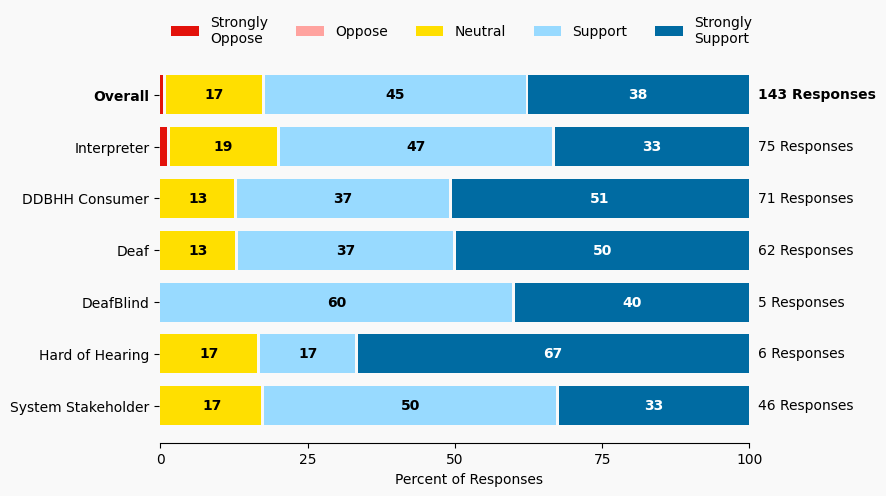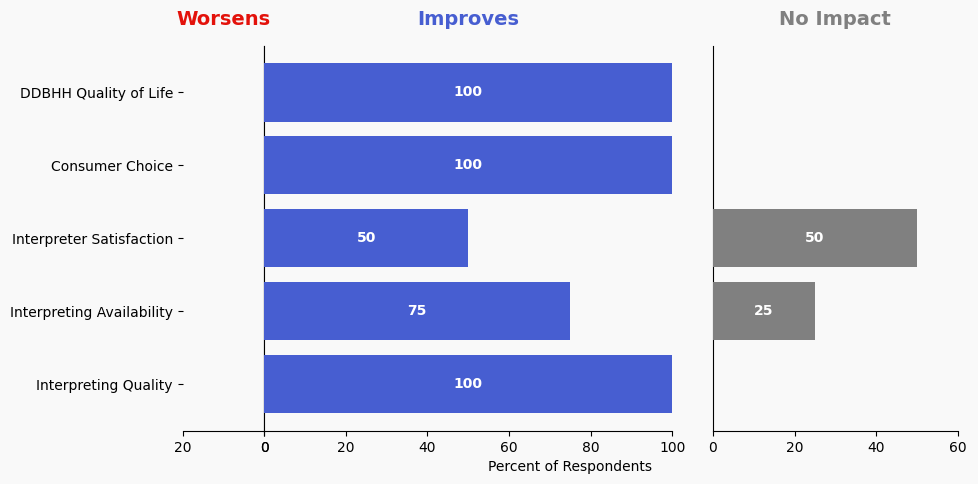3 Commission Lead a Public Campaign to Raise Awareness about the MJB Court Interpreter Program’s ADA Grievance Procedure and Complaint Processes
Issue: The Minnesota Judicial Branch (MJB) ADA Grievance Procedure and Complaint Process are not well publicized to the DDBHH constituents who interact with the courts.
Proposed Solution: The Commission and MJB, in conjunction with the Olmstead Implementation Office and the Disability Law Center, will publicly share MJB’s ADA Grievance Procedure and Complaint Process about interpreting services.
Expected outcome: DDBHH people will become aware of these processes. Concerns about consumers’ communication access can be processed through the ADA Grievance Procedure and Complaint Process. Hopefully the quality of services will improve, particularly if there are patterns in concerns raised.
Who is impacted: consumers
Timeline: 6 months

Summary of Support Image Description
The stacked bar charts show how respondents rated their level of support and the total number of responses. The percentage for the five support levels is shown from left to right: Strongly Oppose (Dark Red), Oppose (Light Red), Neutral (Yellow), Support (Light Blue), and Strongly Support (Dark Blue).
Respondents may identify with multiple subgroups. The overall level of support is:
Overall
Strongly Oppose: 1%
Oppose: 0%
Neutral: 17%
Support: 45%
Strongly Support: 38%
Click to see the detailed image description for each subgroup.
Interpreter
Strongly Oppose: 1%
Oppose: 0%
Neutral: 19%
Support: 47%
Strongly Support: 33%
Deaf
Strongly Oppose: 0%
Oppose: 0%
Neutral: 13%
Support: 37%
Strongly Support: 50%
DDBHH Consumer
Strongly Oppose: 0%
Oppose: 0%
Neutral: 13%
Support: 37%
Strongly Support: 51%
DeafBlind
Strongly Oppose: 0%
Oppose: 0%
Neutral: 0%
Support: 60%
Strongly Support: 40%
System Stakeholder
Strongly Oppose: 0%
Oppose: 0%
Neutral: 17%
Support: 50%
Strongly Support: 33%
Hard of Hearing
Strongly Oppose: 0%
Oppose: 0%
Neutral: 17%
Support: 17%
Strongly Support: 67%
Overview of Respondents Opting for In-Depth Solution Analysis
After indicating their support level, 4% of the 143 respondents opted in to further assess whether the solution would worsen or improve on five metrics. Of the opt-in reviewers (7 respondents), 100% supported the solution, 0% were neutral on the solution, and 0% opposed the solution.
The remaining 136 respondents did not opt in to further assess the solution. Of these people, 81% support the solution, 17% were neutral on the solution, and 0% opposed the solution.
Reviewer Evaluation of Solution Effectiveness

Solution Effectiveness Image Description
The stacked bar charts show how respondents assessed the effectiveness of this solution based on five metrics. For each metric, the percentage of respondents is shown from left to right: Worsens (Red), Improves (Blue), No Impact (Gray).
DDBHH Quality of Life
Makes It Worse 0%
Makes It Better 100%
No Impact 0%
Interpreter Satisfaction
Makes It Worse 0%
Makes It Better 50%
No Impact 50%
Consumer Choice
Makes It Worse 0%
Makes It Better 100%
No Impact 0%
Interpreting Availability
Makes It Worse 0%
Makes It Better 75%
No Impact 25%
Interpreting Quality
Makes It Worse 0%
Makes It Better 100%
No Impact 0%
Reviewer Feedback and Insights
Interpreter
No comments were submitted.
Deaf, DeafBlind, Hard of Hearing
One comment from a DDBHH consumer suggested that this solution could be accomplished quickly with lower funding needs via a social media awareness approach that centralizes messaging among respective organizations.
System Stakeholder
One comment from a System stakeholder highlighted the difficulty in understanding the grievance procedures even for professionals within the MN Disability Law Center and suggested collaboration with other organizations such as State Services and ThinkSelf’s DVSA advocacy programs.
PREVIOUS SOLUTION
2 Commission Host Self-Advocacy Training via Train-the-Trainer
Issue: Not all consumers are confident and comfortable with advocating for interpreting access.
NEXT SOLUTION
4 Educate Potential Hiring Entities & Employers: ADA Responsibilities
Issue: Organizations who need to hire interpreters often do not understand how to obtain quality and qualified interpreting services
Leave a Reply